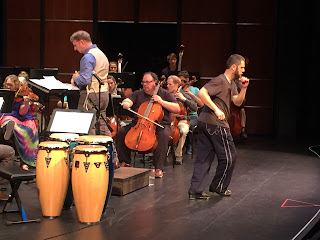Over the past
week, I had the absolute pleasure of performing as a substitute violinist with
the Gainesville Orchestra at Santa Fe College. The Gainesville Orchestra is an incredible group of
musicians directed by multi-talented Mr. Evans Haile. Haile has worked as the
Producing Artistic Director of the Cape Playhouse Center for the Arts, hosted
the NPR show “Talk of the Town,” produced many shows at the Lincoln Center for
Performing Arts, and co-founded the New Amsterdam Theatre Company. In short,
such big talent on such a small local stage!
 |
| The Gainesville Orchestra rehearses in the performing hall at Santa Fe College on Thursday, February 23, 2017. |
The concert’s
theme was centered on a mix of Latin music with driving rhythms and insatiable
pulses. It was rightfully titled Bulla Cubana. But from my perspective, the
most admirable aspect of this concert wasn’t necessarily the music alone – although
it was truly wonderful! – but how the music interacted with the performing
guest artists and even the audience members. The music was playful and flirty
and fit perfectly with the concert hall’s ambience.
 |
| RumbaTap dancer Max Pollack rehearses on stage with the Gainesville Orchestra. |
The stars of the
evening were the internationally renowned RumbaTap dancer Max Pollack and
local artist Eleanor Blair. During the concert, Blair capture the essence of
Cuba by live-painting a scenic portrait of Havana. And, in the second half of
the program, Pollack emerged to show the audience his innovative style of dance
that blends elements of Afro-Cuban music and dance with American rhythmic tap
and body music. The outcome: jaw-dropping artistry.
It is safe to
assume that no one left that concert hall without a smile from ear-to-ear.
Pollack’s dancing was exuberantly cheered, the orchestra’s music was highly
praised, and Blair’s painting was sold for $3,000 to the highest bidder in the
auction that ended the evening’s events. All I have left to say, is that I can
only hope that I am invited to play with orchestra again; it always leaves me
in such great spirits.

